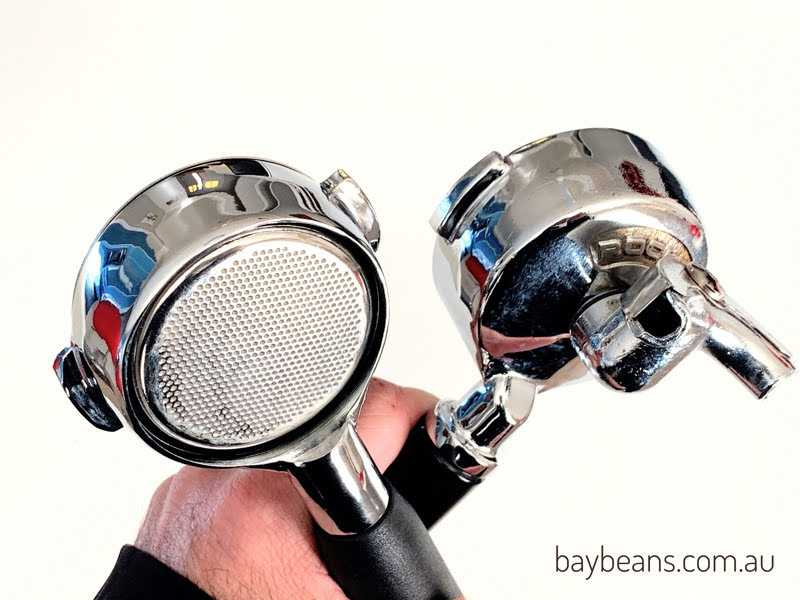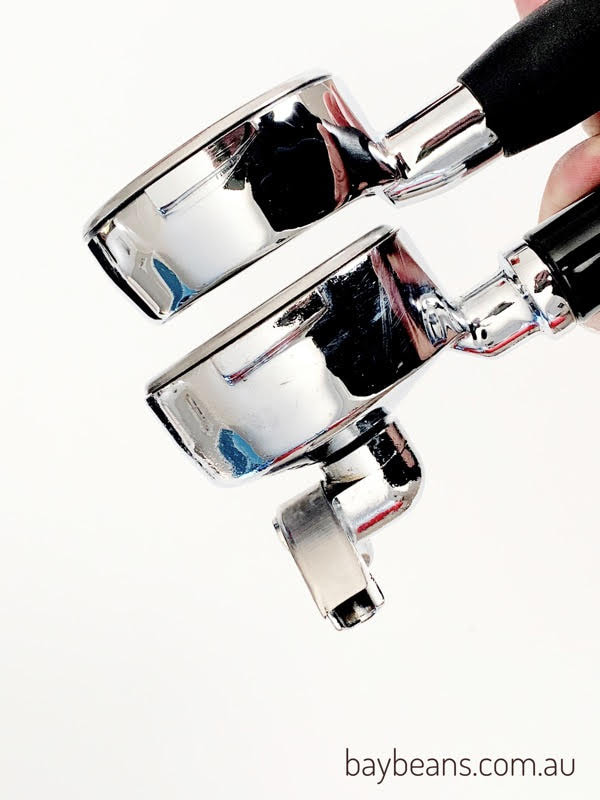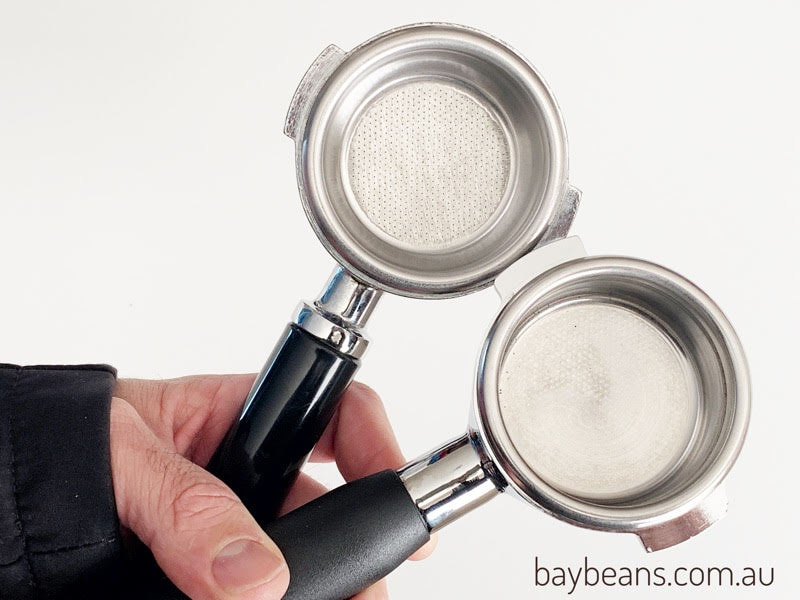Let me start by saying coffee is a science, but that science is also open to creative licence. It’s an important thing to remember because what works well for me and my taste preference will be different to you and your taste preference, and what you make for your friends and family will be different again. That's why cafe barista's can have such a tough time - they cannot appeal to everyone all of the time. They will appeal largely to the people that appreciate their take on what coffee should taste like.
So, what of this science? Science says that a single shot of coffee is 7 grams and that 7 grams should yield 30 mls of espresso base from your espresso machine. Equally true, a double shot is 14 grams producing 60 mls of espresso base and a triple shot is 21 grams producing 90 mls of espresso base. that gives a coffee grind to espresso base yield ratio of 1:4 (IE 7 grams of coffee grinds producing 30 mls of espresso, that is 4.2x the dry weight, or close enough to 1:4)
That said, the modern interpretation of this has changed somewhat. I prefer to both push the single basket capacities up from 7 grams per dose to 9 grams AND reduce the yield to a ratio of 1:2. That means that a single shot of 9 grams of dry weight coffee grinds in a single basket will now produce 18 mls of espresso base, while a double shot of 18 grams in a double shot basket will now produce 36 mls of espresso base and a triple shot of ground coffee equalling 27 grams in a triple shot basket will now produce 54 mls of espresso base.
It’s important to note here that single, double and triple shot baskets are designed to both hold more coffee grounds as well as dispense more coffee liquid. The volume of the basket increases and so does the surface area of the basket base. When you compare a single shot basket to a triple shot basket, the triple shot basket has three times as many holes in the base for the coffee to extract. That allows for the same overall extraction time of a single shot from a single shot basket as a triple shot would extract from a triple basket.
All things being equal in extraction time, grind size, and liquid volume, you cannot upgrade the basket size from a single to a double (or a double to a triple) without also increasing the amount of coffee you put in the basket. Failing to increase the amount of coffee will result in a diluted version of your espresso base since more water is able to base through a larger capacity basket due to there being more holes in the basket base - it needs the extra coffee to create more resistance.
So, what of this science? Science says that a single shot of coffee is 7 grams and that 7 grams should yield 30 mls of espresso base from your espresso machine. Equally true, a double shot is 14 grams producing 60 mls of espresso base and a triple shot is 21 grams producing 90 mls of espresso base. that gives a coffee grind to espresso base yield ratio of 1:4 (IE 7 grams of coffee grinds producing 30 mls of espresso, that is 4.2x the dry weight, or close enough to 1:4)
That said, the modern interpretation of this has changed somewhat. I prefer to both push the single basket capacities up from 7 grams per dose to 9 grams AND reduce the yield to a ratio of 1:2. That means that a single shot of 9 grams of dry weight coffee grinds in a single basket will now produce 18 mls of espresso base, while a double shot of 18 grams in a double shot basket will now produce 36 mls of espresso base and a triple shot of ground coffee equalling 27 grams in a triple shot basket will now produce 54 mls of espresso base.
It’s important to note here that single, double and triple shot baskets are designed to both hold more coffee grounds as well as dispense more coffee liquid. The volume of the basket increases and so does the surface area of the basket base. When you compare a single shot basket to a triple shot basket, the triple shot basket has three times as many holes in the base for the coffee to extract. That allows for the same overall extraction time of a single shot from a single shot basket as a triple shot would extract from a triple basket.
All things being equal in extraction time, grind size, and liquid volume, you cannot upgrade the basket size from a single to a double (or a double to a triple) without also increasing the amount of coffee you put in the basket. Failing to increase the amount of coffee will result in a diluted version of your espresso base since more water is able to base through a larger capacity basket due to there being more holes in the basket base - it needs the extra coffee to create more resistance.
While increasing the ratio will decrease the yield, you are achieving a more concentrated coffee for the same amount of liquid, but the best part of this is you are getting the sweetest part of your extraction and leaving the more bitter half of your extraction in the coffee puck.
When you mix your espresso base with milk if you enjoy flat whites, lattes or cappuccino - you will end up with a coffee to milk ratio of around 1:5. So a double shot of coffee base equalling 36 grams, will mix with 108 mls of milk - when you add those two together, you will have a drink of 144 mls, perfect for a 150 ml cup.
The same ratio will remain for the different cup sizes, only the espresso and milk quantities will increase.
Another interpretation of the triple basket is to produce a more ristretto (held back) form of coffee base. A triple shot extraction of 27 grams of coffee will usually produce 54mls of espresso base. Holding back the last say 14 mls of that extraction will leave you with an incredibly sweet 30 ml shot of espresso base.
Lastly, if your a black drinker and want to make a great Lungo, stretch you ratio to 1:3 or 1:4 so your 27 grams of espresso base will produce 81 ml or 108 ml of espresso base respectively.
When you mix your espresso base with milk if you enjoy flat whites, lattes or cappuccino - you will end up with a coffee to milk ratio of around 1:5. So a double shot of coffee base equalling 36 grams, will mix with 108 mls of milk - when you add those two together, you will have a drink of 144 mls, perfect for a 150 ml cup.
The same ratio will remain for the different cup sizes, only the espresso and milk quantities will increase.
Another interpretation of the triple basket is to produce a more ristretto (held back) form of coffee base. A triple shot extraction of 27 grams of coffee will usually produce 54mls of espresso base. Holding back the last say 14 mls of that extraction will leave you with an incredibly sweet 30 ml shot of espresso base.
Lastly, if your a black drinker and want to make a great Lungo, stretch you ratio to 1:3 or 1:4 so your 27 grams of espresso base will produce 81 ml or 108 ml of espresso base respectively.
A triple size coffee basket wont fit into standard sized coffee portafilters which is where naked, or bottomless portafilters come in. They will allow you to house any size basket you like without the restriction of the base interfering with the fit. The bonus with a naked portafilter is the benefit of being able to see your extraction in progress - a fantastic training aid that is hidden in a traditional filter. You are able to receive instant feedback on your coffee distribution technique, your tamping technique and discover if any of your coffee puck is separating, or channeling to create pathways for your pressurised water to sneak through, resulting in a weaker coffee than if your water was evenly distributed over the entire coffee puck surface and pushed through the puck, taking an equal amount of goodness through to your cup. I'll write some more about naked portafilters soon.
The most important thing to appreciate after all this is to come back to what I said earlier - this science is open to creative licence. So, if you prefer 60ml from a single shot of coffee, that is perfectly fine. its a personal choice - all this information is so you have a basis upon which to experiment.
The most important thing to appreciate after all this is to come back to what I said earlier - this science is open to creative licence. So, if you prefer 60ml from a single shot of coffee, that is perfectly fine. its a personal choice - all this information is so you have a basis upon which to experiment.



 RSS Feed
RSS Feed
